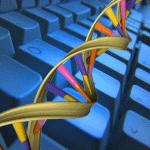Bioinformatics
|
18 december 2014 22:16:35 |
| Non-interacting surface solvation and dynamics in protein-protein interactions (Proteins: Structure, Function, and Bioinformatics) |
|
Tweet Protein-protein interactions control a plethora of cellular processes including cell proliferation, differentiation, apoptosis and signal transduction. Understanding how and why proteins interact will inevitably lead to novel structure-based drug design methods, as well as design of de novo binders with preferred interaction properties. At a structural and molecular level, interface and rim regions are not enough to fully account for the energetics of protein-protein binding, even for simple lock-and-key rigid binders. As we have recently shown, properties of the global surface might also play a role in protein-protein interactions. Here, we report on molecular dynamics simulations performed to understand solvent effects on protein-protein surfaces. We compare properties of the interface, rim and non-interacting surface regions for five different complexes and their free components. Interface and rim residues become, as expected, less mobile upon complexation. However, non-interacting surface appears more flexible in the complex. Fluctuations of polar residues are always lower compared to charged ones, independent of the protein state. Further, stable water molecules are often observed around polar residues, in contrast to charged ones. Our analysis reveals that (a) upon complexation, the non-interacting surface can have a direct entropic compensation for the lower interface and rim entropy and, (b), the mobility of the first hydration layer, which is linked to the stability of the protein-protein complex, is influenced by the local chemical properties of the surface. These findings corroborate previous hypotheses on the role of the hydration layer in shielding protein-protein complexes from unintended protein-protein interactions. This article is protected by copyright. All rights reserved. |
| 168 viewsCategory: Biochemistry, Bioinformatics |
 Structural templates for comparative protein docking (Proteins: Structure, Function, and Bioinformatics) Structural templates for comparative protein docking (Proteins: Structure, Function, and Bioinformatics)Refinement by shifting secondary structure elements improves sequence alignments (Proteins: Structure, Function, and Bioinformatics) 
|
| blog comments powered by Disqus |
MyJournals.org
The latest issues of all your favorite science journals on one page
The latest issues of all your favorite science journals on one page



